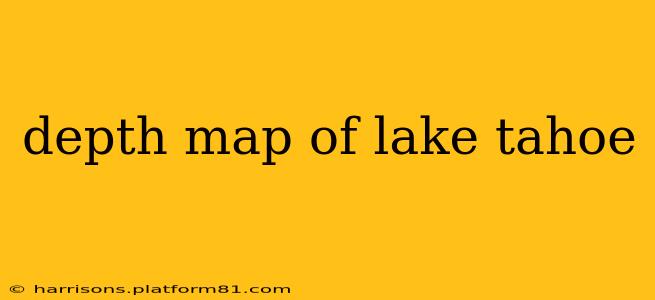Lake Tahoe, renowned for its breathtaking beauty and crystal-clear waters, holds secrets beneath its surface. Understanding the lake's bathymetry – the measurement and charting of its depths – is key to appreciating its ecological complexity and managing its delicate ecosystem. This exploration delves into the intricacies of Lake Tahoe's depth map, revealing its unique features and the scientific methods used to create it.
What is a Depth Map and Why is it Important for Lake Tahoe?
A depth map, or bathymetric map, is a graphical representation of the underwater terrain of a lake or ocean. It illustrates the varying depths, revealing underwater features like valleys, ridges, and the overall shape of the lakebed. For Lake Tahoe, this map is crucial for several reasons:
- Environmental Monitoring: Understanding the lake's depth profile helps scientists monitor water quality, track sediment movement, and assess the impact of human activities on the ecosystem. Changes in depth can indicate erosion, sedimentation, or other environmental shifts.
- Resource Management: Accurate depth data is essential for managing resources like fisheries and ensuring the sustainability of aquatic life.
- Navigation and Safety: Depth maps are vital for safe navigation, especially for larger vessels and recreational boaters. Knowing the underwater terrain helps prevent accidents and damage to boats.
- Scientific Research: The depth map provides a foundation for numerous scientific studies on Lake Tahoe's geology, hydrology, and ecology.
How is Lake Tahoe's Depth Measured?
Creating a detailed depth map of a large lake like Tahoe requires sophisticated technology and techniques. Historically, this involved laborious manual soundings using weighted lines. However, modern methods are far more efficient and precise:
- Sonar (Sound Navigation and Ranging): This technology utilizes sound waves to measure the distance to the lakebed. Sonar systems mounted on boats emit sound pulses, and the time it takes for the echoes to return is used to calculate depth. Multibeam sonar provides extremely detailed, high-resolution data covering wide swathes of the lakebed.
- LiDAR (Light Detection and Ranging): While primarily used for mapping above water, airborne LiDAR can also penetrate the surface to reveal shallow areas and shoreline features. This helps to create a complete picture of the lake's perimeter and shallower regions.
What are the Key Features Revealed by Lake Tahoe's Depth Map?
Lake Tahoe's depth map reveals a surprisingly complex underwater landscape:
- Maximum Depth: Lake Tahoe boasts a remarkable maximum depth of over 1,645 feet (501 meters), making it the second deepest lake in the United States.
- Average Depth: The average depth is approximately 1,000 feet (305 meters), highlighting the overall deep nature of the lake.
- Submerged River Channels and Canyons: The map reveals ancient river channels and canyons carved into the lakebed, providing clues to the geological history of the Tahoe Basin.
- Steep Slopes and Relatively Flat Bottom: While the shoreline slopes steeply in many areas, the deeper parts of the lakebed are relatively flat, forming a vast basin.
What are the Implications of Lake Tahoe's Depth for its Ecology?
The lake's significant depth profoundly impacts its ecosystem:
- Water Temperature Stratification: The deep waters create distinct layers of water with different temperatures and oxygen levels, influencing the distribution of aquatic life.
- Light Penetration and Photosynthesis: Light penetration is limited in the deeper parts of the lake, affecting the growth of aquatic plants and algae.
- Nutrient Cycling: The depth and stratification influence nutrient cycling and the overall productivity of the lake ecosystem.
How Accurate is Lake Tahoe’s Depth Map?
The accuracy of Lake Tahoe's depth map depends on the technology and methods used to create it. Modern multibeam sonar systems provide highly accurate measurements, but some uncertainties remain, particularly in areas with complex underwater features or significant sediment accumulation. Ongoing research and updates refine the map's accuracy over time.
What is the Future of Lake Tahoe Depth Mapping?
Continued research and technological advancements promise even more precise and detailed depth maps of Lake Tahoe. The integration of various data sources, including sonar, LiDAR, and other remote sensing technologies, will enable a more comprehensive understanding of the lake's underwater environment. This will be crucial for long-term environmental monitoring and effective management of this precious natural resource.
This comprehensive overview highlights the importance of Lake Tahoe's depth map in understanding and protecting this iconic lake. The continued exploration and refinement of bathymetric data will be crucial for its preservation for generations to come.
